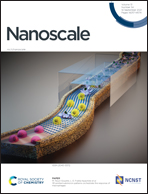Effect of the reduced graphene oxide (rGO) compaction degree and concentration on rGO–polymer composite printability and cell interactions†
Abstract
Graphene derivatives combined with polymers have attracted enormous attention for bone tissue engineering applications. Among others, reduced graphene oxide (rGO) is one of the preferred graphene-based fillers for the preparation of composites via melt compounding, and their further processing into 3D scaffolds, due to its established large-scale production method, thermal stability, and electrical conductivity. In this study, rGO (low bulk density 10 g L−1) was compacted by densification using a solvent (either acetone or water) prior to melt compounding, to simplify its handling and dosing into a twin-screw extrusion system. The effects of rGO bulk density (medium and high), densification solvent, and rGO concentration (3, 10 and 15% in weight) on rGO dispersion within the composite, electrical conductivity, printability and cell–material interactions were studied. High bulk density rGO (90 g L−1) occupied a low volume fraction within polymer composites, offering poor electrical properties but a reproducible printability up to 15 wt% rGO. On the other hand, the volume fraction within the composites of medium bulk density rGO (50 g L−1) was higher for a given concentration, enhancing rGO particle interactions and leading to enhanced electrical conductivity, but compromising the printability window. For a given bulk density (50 g L−1), rGO densified in water was more compacted and offered poorer dispersability within the polymer than rGO densified in acetone, and resulted in scaffolds with poor layer bonding or even lack of printability at high rGO percentages. A balance in printability and electrical properties was obtained for composites with medium bulk density achieved with rGO densified in acetone. Here, increasing rGO concentration led to more hydrophilic composites with a noticeable increase in protein adsorption. Moreover, scaffolds prepared with such composites presented antimicrobial properties even at low rGO contents (3 wt%). In addition, the viability and proliferation of human mesenchymal stromal cells (hMSCs) were maintained on scaffolds with up to 15% rGO and with enhanced osteogenic differentiation on 3% rGO scaffolds.



 Please wait while we load your content...
Please wait while we load your content...